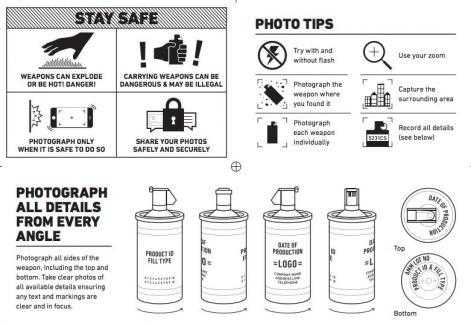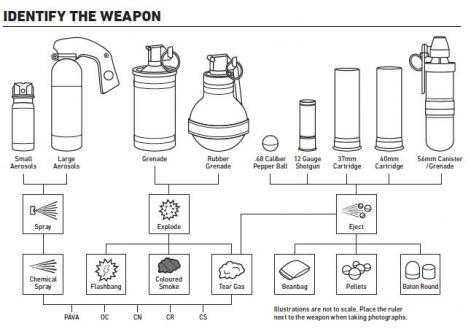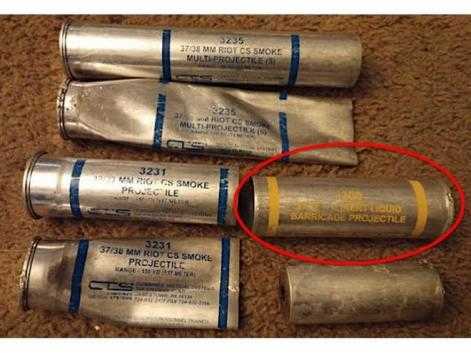#RiotID
The RiotID Team
What is Riot ID?
RiotID (http://riotid.com) is a civic media project helping people identify, monitor and record the use of riot control agents against civilians. The project is collaboration between researchers from Bournemouth University, Birmingham University and Omega Research Foundation, with Minute Works graphic design.
Everyday, around the world, law enforcement officers use tear gas, stun grenades, rubber bullets and other riot control weapons on civilians. While these devices are marketed as safe and humane ‘less lethal’ weapons, they regularly cause injuries and even deaths.
The #RiotID pocket guide was designed to be a mobile, reproducible and easily translatable print guide that can help train people to better record and identify less lethal weapons. Making accurate identifications of less lethals can help people medically respond to the effects of exposure and injury, monitor human rights violations, challenge use of force abuses, and identify the manufacturer and country of origin of these devices.
How Does Riot ID Work?
#RiotID works in two steps. First, people on location photo document riot control technologies. By following the instructions for taking photographs provided in the #RiotID pocket book, people can learn the best techniques for recording and photo-documenting all the information needed to do an identification. This includes, photographing the device from all angles and recording all numeric and text information, both around the object and on its top and bottom.
Next is step two, using the documented features of the weapon to figure out what it is, as well as the supplier and country of origin. To help people learn to make identifications, we designed a tree diagram that uses the shape and size of different equipment, along with details on different kinds of less lethal impact and chemical munitions. Once a device is narrowed down to its size (ie 12 guage, 37mm, 56mm) and type (ie flashbang, OC, baton round) it is easier to identify the manufacturer as different companies make and specialize in different products. For help with identifications, people can tweet their photos to @riotID or using the hashtag #riotID. This twitter activity is monitored by the riotID team who draw on their expert knowledge to help match photographs of weapons being used on the street and where they come from.
An important aspect of this identification process is checking the expiry date on munitions. It is all too common to find police forces using out of date products. Since RiotID launched in August 2015, we identified expired canisters being used in Uganda, Zambia and Mexico. Expired products Expired tear gas is dangerous for a number of reasons. First, the mechanism that sets off the canister and grenade can become faulty. This can lead to injury for personnel using the device. It can also make incendiary devices increasingly likely to cause fires. Secondly, the chemical compound contained in the grenade may not be approved according to the most recent safety tests and certificates. Thirdly, it is even more difficult to trace expired gas to their point of sale than unexpired tear gas. Just as it is unclear whether Condor is directly supplying certain countries with these devices, it is also unclear why expired gas is still in circulation on the streets. Old equipment is meant to be taken out of rotation and destroyed according to careful environmental protocols for waste disposal.
On 19 August 2015, protests took place in a Northern St. Louis neighbourhood following the deadly shooting of 18 year old Mansur Ball-Bey by police officers. The police officers claim they fired after the young man allegedly pulled a gun.
According to media reports, riot police were called in to respond to protests, firing tear gas, smoke grenades and other riot control weapons on the residential intersection where community members gathered, blocking an intersection.
A local woman photo documenting the protests on her mobile phone, posted a series of images to twitter of the riot control weapons being used. Among the weapons she documented, #RiotID identified what appears to be a 37MM Inert Liquid Barricade, Model 3300. This weapon is designed for indoor use in a hostile environment, where a perpetrator is armed and barricaded indoors, such as in a hostage situation. A caution label from the manufacturer reads:
According to an article in The Atlantic, Police Chief Sam Dotson stated in a press conference that inert gas was used to attempt to disperse protesters. It is unclear if the police chief knew that the type of inert gas deployed outside on the street, included this dangerous indoor barricade penetrator.
As clearly marked on the weapon's specification sheet, the 3300 is not designed for outdoor use on crowds. Dislodging this weapon on the street against civilians would be a clear violation of guidelines, putting human lives at risk of serious injury and death.
Holding Corporations Accountable
The United States is not the only home of world’s less lethal weapons manufacturers. This transnational trade spans six continents, with leading manufacturers exporting their goods around the world.
Rio-based Condor Nonlethal Technologies (“Condor”) has taken full advantage of the business opportunities provided by Brazil hosting both the 2014 World cup and 2016 Olympic Summer Games. Condor is one of the world’s leading suppliers of policing equipment and the largest company of its kind in Latin America. Recently a company spokesperson aid the manufacturer has been working night and day to fulfil product demands. Since 1985 Condor has developed over one hundred distinct products for the military, UN peacekeeping forces, special operations forces and mainstream law enforcement. Today Condor produces a wide range of these policing and crowd control munitions. Types of tear gas projectiles include triple and multiple charges, canisters that split into pieces to allow for greater coverage and are designed to be more difficult to “throw back” (where a civilian picks up and throws a projectile back toward police lines, or away from a crowd).
Rheinmetall Denel, a venture between Germany and South Africa, supplies less lethal weapons around the world. According to a December 2014 report in the Wall Street Journal, German defence manufacturer Rheinmetall benefits from its partnership with South African Denel because this alliance allows for munitions to be manufactured from South Africa, rather than in Germany, where patent and export controls are tighter. Operating from South Africa, Denel is known for its participation in the apartheid regime, providing a main source of armaments. With aim to further expand its international reach, in June 2015, Reuters reported the company was looking to set up manufacture in the Philippines.
In France, less lethal weapons are often deployed against non-violent protesters by French police forces. In 2014, 21-year-old Rémi Fraisse was killed by an SAE Alsetex by a stun grenade explosion after police fired these munitions on unarmed civlians during protests against airport expansion. Other young people that are part of the ZAD movement have lost eyes, suffered concussions and been marred by serious injury caused by the excessive and unsafe use of France’s less lethal weapons. Protests swept France following Rémi’s death. Many of these demonstrations against police use of excessive force were met with an abundance of riot control weapons.
In August 2015 our RiotID team identified Alsetex’s Cougar munitions launchers being used out on the streets in Lebanon during the recent ‘You Stink’ garbage protests against government failure and corruption. Cougar launchers. The amount of excessive force used by police against peaceful civilians during these protests came under condemnation by human rights groups, leading Prime Minister Tammam Salam to announce that security forces would face “accountability and follow-up."
Operating from South Korea, Korea C.N.O. Tech is one of several South Korean companies that sells less lethal weapons including tear gas and foam rounds. Tear gas canisters with the C.N.O. Tech logo on were photographed in Turkey in 2013 and black tear gas canisters thought to be South Korean have been photographed in Bahrain.
Linking the technologies being used against civilians to the manufacturers that supply them helps people hold corporations accountable. It can support efforts to intervene in human rights abuses, monitor illegal exports, enforce protocols and curb deadly practices. By treating less lethals as both repressive and potentially deadly weapons, the Riot ID project makes visible those companies who profiteer off the violent control of protest.
Riot ID in Translation
In efforts to reach more people and represent the transnational nature of this trade, Riot ID has teamed up with volunteer translators to create versions of the pocket book in French, German, Spanish, Turkish and Arabic. If you or your organization would like to be involved in translating RiotiD into another language, please be in touch. You can download the English and translated versions of #RiotID from our website at http://riotid.com/print-your-own-riotid/









Add new comment